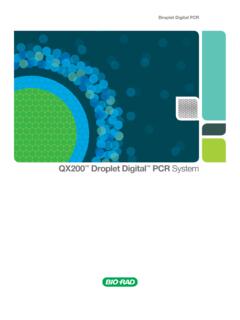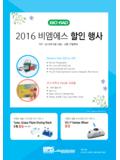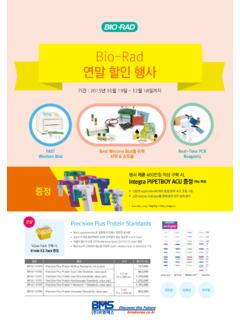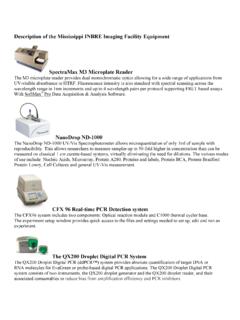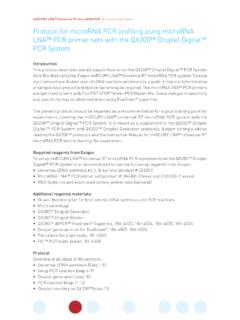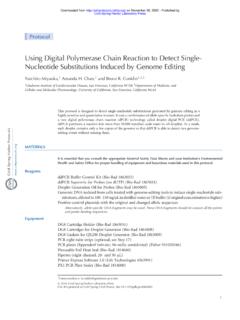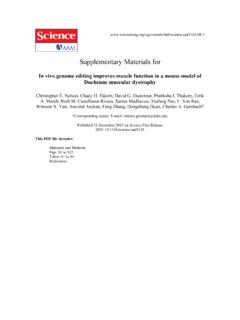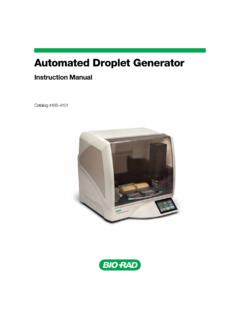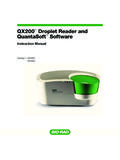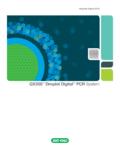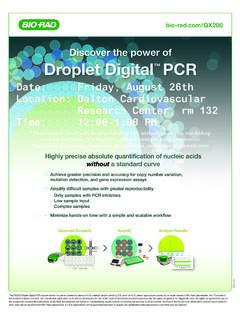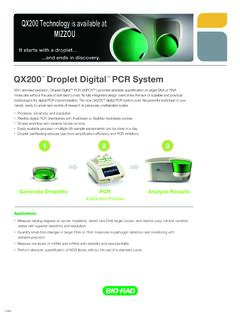Transcription of Evaluation of a Droplet Digital Polymerase Chain Reaction ...
1 Evaluation of a Droplet Digital Polymerase Chain Reaction Formatfor DNA Copy Number QuantificationLeonardo B. Pinheiro,*, Victoria A. Coleman, Christopher M. Hindson, Jan Herrmann, Benjamin J. Hindson, Somanath Bhat, and Kerry R. Emslie National Measurement Institute, Lindfield, New South Wales, Australia Bio-Rad Laboratories, Inc., Pleasanton, California, United States*SSupporting InformationABSTRACT: Droplet Digital Polymerase Chain Reaction (ddPCR) is a newtechnology that was recently commercialized to enable the precisequantification of target nucleic acids in a sample. ddPCR measures absolutequantities by counting nucleic acid molecules encapsulated in discrete,volumetrically defined, water-in-oil Droplet partitions. This novel ddPCRformat offers a simple workflow capable of generating highly stable partitioningof DNA molecules.
2 In this study, we assessed key performance parameters ofthe ddPCR system. A linear ddPCR response to DNA concentration wasobtained from through to saturation in a 20,000 Droplet assaycorresponding to more than 4 orders of magnitude of target DNA copynumber per ddPCR. Analysis of simplex and duplex assays targeting two distinct loci in the Lambda DNA genome using theddPCR platform agreed, within their expanded uncertainties, with values obtained using a lower density microfluidic chamberbased Digital PCR (cdPCR). A relative expanded uncertainty under 5% was achieved for copy number concentration usingddPCR. This level of uncertainty is much lower than values typically observed for quantification of specific DNA target sequencesusing currently commercially available real-time and Digital cdPCR ability to quantify nucleic acids with accuracy andprecision is fundamental to many fields of basic research,molecular diagnostic tests, and commercial processes.
3 Althoughreal-time Polymerase Chain Reaction (PCR) has found wide-spread utility for nucleic acid quantification, it requires thecomparison of an unknown to a standard to obtain quantitativeinformation. Real-time PCR is an analogue measurement basedon monitoring amplification after each cycle of PCR usingfluorescence probes. The point at which the Reaction fluore-scence crosses an intensity threshold is called the cycle threshold(Ct). As many factors can influence PCR efficiency and hence theCt value, the accuracy and precision of real-time PCR can principle of Digital PCR was first introduced in the1990s1,2and is increasingly being utilized for quantification ofDNA 5 Digital PCR is an end-point measurement thatprovides the ability to quantify nucleic acids without the use ofstandard curves. In a typical Digital PCR experiment, the sampleis randomly distributed into discrete partitions, such that somecontain no nucleic acid template and others contain one ormore template copies.
4 The partitions are thermally cycled toend-point and then read to determine the fraction of positivepartitions, from which the concentration is calculated usingeq MPRln 1copy number per Droplet (1)whereMis the average number of target molecules perpartition,Pis the number of partitions containing amplifiedproduct, andRis the number of partitions or key factors influence the reliability of Digital PCRmeasurements: the number of reactions analyzed (R) and thenumber of template molecules in the concen-tration is derived by dividing the copy number estimate by theassay volume, an additional key factor, partition volume (Vd)(and its associated uncertainty) needs to be considered whenmeasuring DNA concentration using Digital , the commercially available microfluidic chamberbased Digital PCR (cdPCR) formats contain up to a fewthousand individual reactions or microfluidic chambers for eachtechnical replicate.
5 Using these formats, confidence in theestimated copy number can be improved by increasing thenumber of technical replicates and hence, the total number ofreactions analyzed. However, there have been practicallimitations, primarily cost, to the number of technical replicatesthat can be analyzed by cdPCR. A new dPCR format calledDroplet Digital PCR (ddPCR) has recently been single ddPCR is comprised of approximately 20 000partitioned droplets, a number which is about 25 times the 765 Received:September 29, 2011 Accepted:November 28, XXXX American Chemical | , XXX, XXX XXXchambers of a single sample panel on a microfluidic this study, we evaluated key factors that can influence thereliability of results obtained from an early access beta-prototypeddPCR system (Bio-Rad, Pleasanton, CA). The linearity of theresponse and the precision over the dynamic range of the 20 000- Droplet assay (referred to as 20 000-ddPCR) were assessed.
6 Sincethe droplets are generated from a single-use eight channel dropletgenerator cartridge, we examined both the intra- and inter-cartridge repeatability of assays. Copy number concentration andratio together with their expanded uncertainties were assessedusing both a high density ddPCR technology and a lower densitycdPCR platform. EXPERIMENTAL SECTIONL ambda DNA Solution and PCR DNAsolution (Fermentas) was analyzed using the primer and probesequences and concentrations for assays 2 and 5 as (Table S-1 in the Supporting Information). Assays2 and 5 target different regions of the Lambda DNA genome(5 base of the amplicon is 16 541 and 44 925, respectively,in the 48 502 base pair Lambda DNA genome) and pro-duce amplicons of 188 and 76 base pair (bp), Lambda DNA was used as supplied and not physically orenzymatically treated to reduce fragment length prior Digital PCR Instrumentation, Workflow, andData experimental work including ddPCR anddroplet volume measurements was conducted at the NationalMeasurement Institute, Australia.
7 Reaction mixtures of 20 Lvolume comprising 1 ddPCR Master Mix (Bio-Rad), relevantforward and reverse primers and probe(s) (Table S-1 in theSupporting Information), and DNA were prepared using agravimetric protocol to minimize the uncertainty due topipetting. The ddPCR reagents, except DNA, were premixedand the final Reaction mix was prepared gravimetrically bycombining the DNA and PCR components (SupportingInformation S-1). Each 20 L Reaction was dispensed into aseparate well of a disposable eight channel Droplet generatorcartridge (Figure 1A; Bio-Rad). A volume of 60 L of dropletgeneration oil (Bio-Rad) was then loaded into each of thecorresponding oil wells before the consumable chip was loadedinto a beta-prototype Droplet generator (Bio-Rad). The dropletgenerator applies a vacuum to each of the outlet wells togenerate droplets in the eight channels simultaneously at a rateof 1 000 droplets/channel/second until the complete 20 LddPCR mixture has been partitioned into the monodispersewater-in-oil emulsion format.
8 Each water-in-oil emulsion wastransferred by pipet to a separate well of a 96-wellpolypropylene plate (Eppendorf), heat sealed with foil, andamplified in a conventionalcalibrated thermal cycler(Eppendorf Mastercycler ep S thermocycler). Thermalcycling conditions consisted of a 10 min activation period atFigure showing the ddPCR workflow. (A) Each 20 L sample containing the Master Mix, primers, TaqMan probes, and DNA target isloaded in the middle wells of a disposable eight channel Droplet generator cartridge (pictured). Droplet generation oil (8 60 L) containing theemulsion stabilizing surfactant is then loaded into the left-hand wells of the Droplet generator cartridge. A vacuum is automatically applied to theoutlet well (right) creating a pressure difference that, together with the geometry of the microfluidic circuit, converts the aqueous sample into stable,monodisperse, water-in-oil Droplet emulsions which concentrate due to density differences from the oil phase and accumulate in the dropletcollection wells of the cartridge.
9 The droplets from each well are then transferred to one well of a 96-well plate, foil sealed, and thermal-cycled to theend-point. (B) After amplification, the plate is then loaded to a Droplet reader where an autosampler aspirates the droplets and, using a microfluidicsingulator, streams them single file ( 1500 droplets/s) past a FAM/VIC two color fluorescence detector which samples at a rate of 100 kHz. (C)The difference in fluorescence amplitudes for droplets where amplification has or has not occurred (positive and negatives, respectively) dividestheentire Droplet population into four discrete clusters for a typical Fam/Vic duplex assay. These four populations are droplets containing either notarget (F /V ), one of the targets (F /V+, F+,V ), or both targets (F+,V+). Setting a fluorescence threshold for each detection channel affords adigital method of Droplet classification and computing the average number of copies per Droplet based on the fraction of positive droplets andPoisson | , XXX, XXX XXXB95 C followed by 40 cycles of a two step thermal profile of15 s at 94 C denaturation and 60 s at 60 C for combinedannealing-extension at 100% ramp rate and a final 10 mininactivation step at 98 C.
10 After thermal cycling, plates weretransferred to a beta-prototype Droplet reader (Bio-Rad) thatemploys an integrated autosampler and fluidics to seriallyaspirate droplets from each well and stream them single-file,at a rate of 1 500 droplets/second, past a two-colorfluorescence detector sampled at a rate of 100 kHz on bothFAM and VIC fluorescence channels (Figure 1B). Sampling at100 kHz affords the ability to gate outliers on a case-by-casebasis using properties of the fluorescence trace (automated byBio-Rad Signal Processing Algorithm ). Discriminationbetween droplets that did not contain target (negatives) andthose which did (positives) was achieved by applying a globalfluorescence amplitude threshold in QuantaSoft (Bio-Rad), thesoftware package provided with the ddPCR system for dataacquisition and analysis. The Droplet reader was calibrated onceupon installation of the ddPCR system at the National Mea-surement Institute, Australia.
